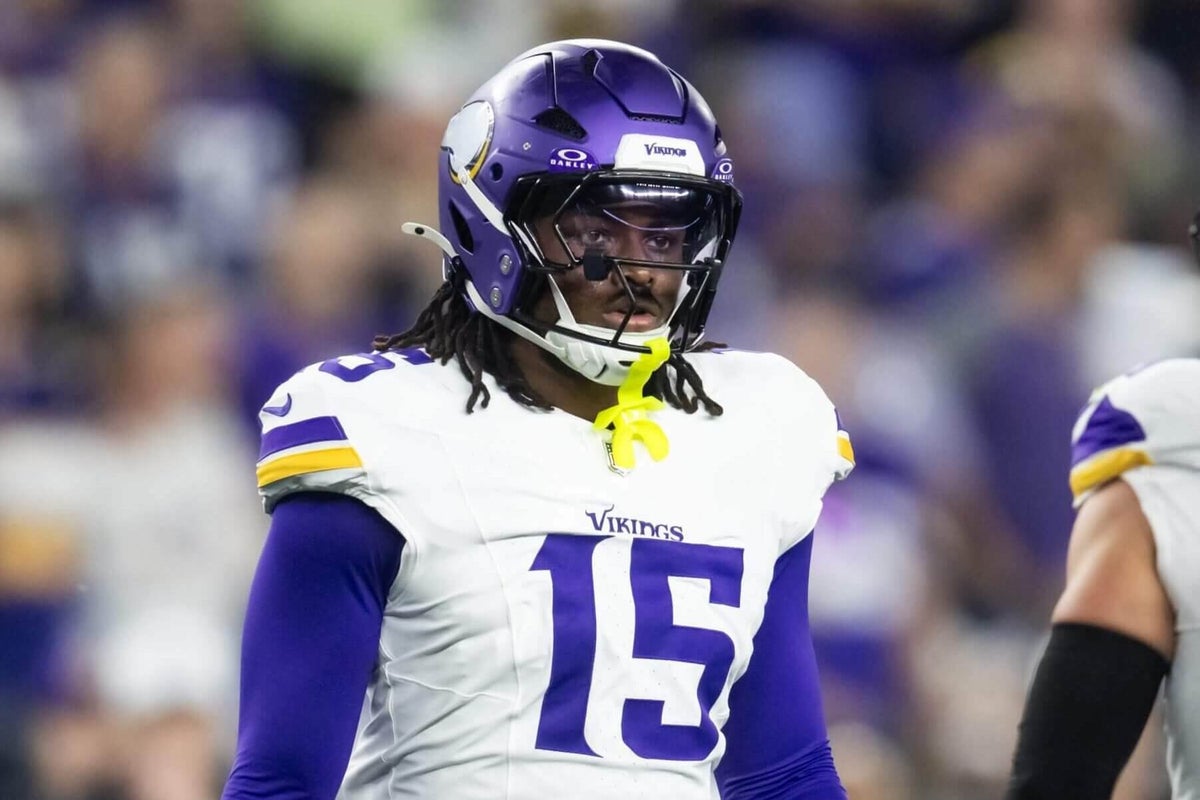EAGAN, Minn. — Evaluating an edge rusher against Lane Johnson is like taking stock of a steak you made alongside the nicest cut of meat at Manny’s.
There are levels of quality offensive linemen in the NFL, and Johnson occupies a spot at the top of the pyramid.
Just ask Micah Parsons, who earlier this year said, “Lane has such an anchor. He just anchors down. He has this wide set, and he just grabs you with his long arms. But he’s strong as hell, and I don’t think people realize that. He’s just a pain to deal with on Sundays.”
How is this relevant to the Minnesota Vikings? Well, they just faced Johnson and his Philadelphia Eagles. Specifically, 2024 first-round pick Dallas Turner was Johnson’s primary foe.
The 22-year-old lined up near Johnson on almost 30 defensive snaps. Most of the Vikings’ defensive calls tasked Turner with taking on Johnson one-on-one. Using the tape of their matchups as a measuring stick is unfair to any 22-year-old. The pick with which the Vikings selected Turner, though, was acquired in exchange for a substantial amount of draft capital. That package almost demands he develop into the type of player who is fair to assess against an All-Pro like Johnson.
Turner is not there yet. Sunday made that crystal clear. But there is something to be said for the way he kept coming. Diffused as many times as he was, Turner still chased Eagles quarterback Jalen Hurts from the pocket to the sideline on a snap early in the fourth quarter.
“It was definitely a good challenge,” Turner said Tuesday of facing off against Johnson. “Some good work.”
Assessing Turner’s performance through six games is a matter of perspective. He has solidly completed his assignments, especially in terms of setting the edge and covering underneath zones. So it’s not wrong to say he’s been successful. But is it fair to expect him to flash elite pass-rushing potential? Probably.
And in that context, his second season has been less inspiring.
The numbers are one thing. Turner’s pass-rush win rate ranks 78th among 116 qualified NFL defenders, according to Pro Football Focus. His pressure-rate metrics are a bit rosier, but his 1.5 sacks (coming at an average length of 4.8 seconds) speak to him benefiting from being in clean-up position.
.@UnoErra with the takedown!
📺: @SNFonNBC pic.twitter.com/JqNYKeRJa1
— Minnesota Vikings (@Vikings) September 15, 2025
Observing his play paints a fuller picture. Turner utilizes his long arms as a primary attack strategy, attempting to garner first contact with the opposing tackle and use that force to back the tackle up into the quarterback’s lap. Some tackles who have trouble anchoring may be susceptible to this approach. The best, like Johnson, aren’t.
But for one successful rush early in the second quarter Sunday, Turner was snatched by Johnson and stood up. Twice, linebacker Eric Wilson created congestion in the pocket with blitzes, requiring additional protection from Eagles running back Saquon Barkley. Those two plays were the closest Turner came to Hurts.
“He’s had a lot of snaps and some impactful plays,” Vikings coach Kevin O’Connell said Tuesday. “We’re asking him to do quite a bit, especially in our emphasis of trying to stop the run last week.”
Interestingly, most of Philadelphia’s rushes were to the side opposite of Turner. He was often left to occupy gaps on the backside.
His strength is one of the noticeable advancements from 2024 to 2025. He bulked up. O’Connell frequently praised Turner throughout training camp, and he played 29 snaps in the team’s opener at Chicago. Andrew Van Ginkel’s concussion and neck injury have given him more opportunities to acclimate to NFL speed.
Minnesota’s coaching staff has also praised Turner’s aptitude. The team has not limited him to a finite role. He lines up on the short side of the field and the wide side of the field. He drops into coverage.
“His knowledge of what we’re asking him to do has grown, and you’re seeing him start to play faster because he’s more comfortable,” Vikings outside linebackers coach Thad Bogardus said recently. “Now, every time you give him a piece of information, he takes it, and you can see growth.”
The subject of Turner’s development becomes more complex when you consider the dynamics of his drafting. The Vikings essentially traded their second-, fifth- and sixth-round picks in 2024 and their second-, third- and fourth-round picks in 2025 to add Turner. Hindsight also allows for the mention of the Los Angeles Rams selecting Jared Verse two picks later.
There are various layers to the decision, too. Had the Seattle Seahawks not taken Byron Murphy II, would the Vikings have made the deal and taken Turner? Is it correct to include the above draft capital when some of those picks were initially intended to be used in a big swing at quarterback? Answers to those questions are worth chewing on.
But at this point, they’re secondary.
Minnesota is a team without much budding young talent, and its defense is emerging from a game in which pass-rush production was a significant issue. Only eight teams have fewer hits on opposing quarterbacks. This season, only the Saints have a slower average time to sack than the Vikings.
In previous offseasons, general manager Kwesi Adofo-Mensah has said that first- and second-rounders are premium picks with the potential to change your team. Turner needs to be one of those players — and sooner rather than later.

